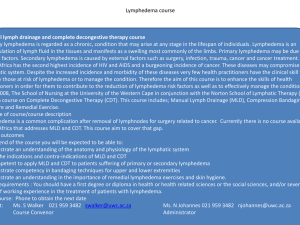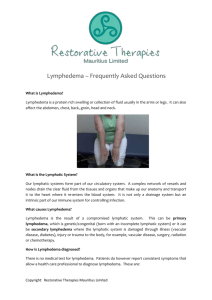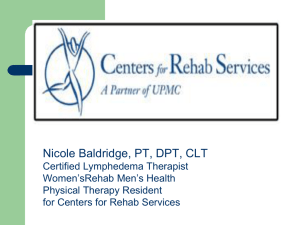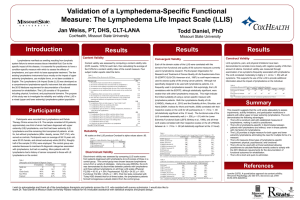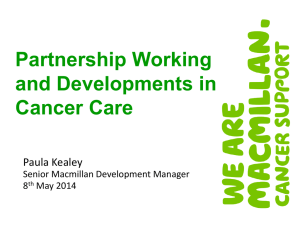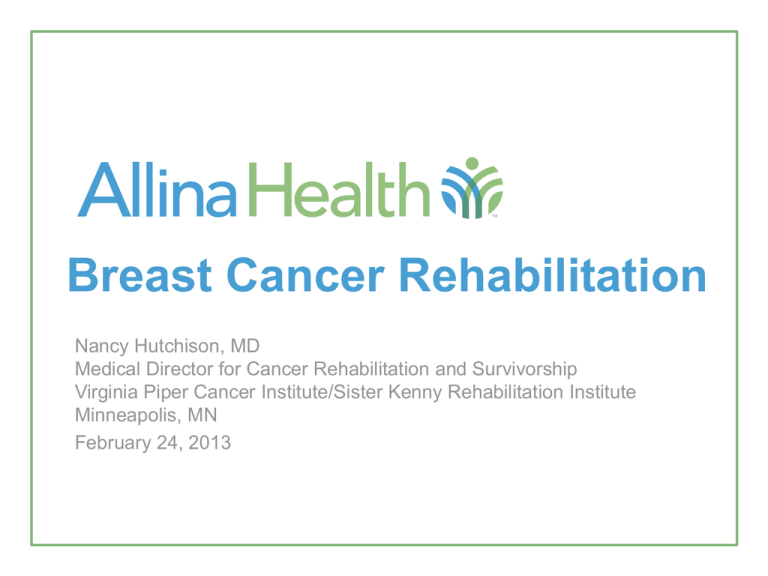
Breast Cancer Rehabilitation
Nancy Hutchison, MD
Medical Director for Cancer Rehabilitation and Survivorship
Virginia Piper Cancer Institute/Sister Kenny Rehabilitation Institute
Minneapolis, MN
February 24, 2013
Rehabilitation is a Commission on Cancer Requirement
for Hospital Cancer Program Accreditation
• Commission on Cancer Standard E.11
• The accredited cancer program must provide
the Commission on Cancer a copy of the
policy or procedure that ensures access to
rehabilitation services and identifies the
rehabilitative services that are provided either
on-site or by referral.
http://www.facs.org/cancer/coc/cocprogramstandards2012.pdf
Cancer Rehabilitation is Function Driven Care
with therapies designed to
minimize
the functional damage imposed by cancer
treatment,
to rehabilitate and restore optimal health and
wellbeing
Physical Medicine and Rehabilitation Specialty
has the Model for Cancer Rehabilitation
Oncology survivorship should utilize
“existing models of rehabilitation care
…pioneered in the specialty of Physical
Medicine and Rehabilitation”
Alfano, C et al. Cancer Survivorship and Cancer Rehabilitation: Revitalizing the
Link. Journal of Clinical Oncology. 2012. 30:9. 904-906
Physical Medicine & Rehabilitation MD
• One of the 24 medical specialties certified by the American
Board of Medical Specialties.
• 4 year residency: Diagnosis and treatment techniques that are
function-oriented and can affect any organ system
• Training in neurology, orthopedics, rheumatology, pain
management (interventional), neuro-diagnostic tests
(EMG), disability, psychology, social services, outcomes
assessment and team leadership
• The only medical specialty specifically trained to evaluate
impairment (loss of function)
• Restores optimal function using a holistic, team, patientfocused approach
http://www.allinahealth.org/ahs/rehab.nsf/page/MHCNHutchison0612.pdf/$FILE/MHCNHutchison0612.pdf
Copy and paste into your browser, then open the pdf
Rehabilitation targets the neuromuscular control of
surrounding structures and lymphatic vessels that
drain affected areas
Side effects of breast cancer
treatment improved by rehabilitation
•
•
•
•
•
•
•
•
•
•
Skin and muscle tightness
Axillary Web Syndrome, axillary cords
Weakness of core and/or shoulder muscles
Lymphedema of chest and/or arm
Excess contractions in reconstruction muscles
Loss of the affected muscle’s position sense
Fatigue
Joint Pain
Neuropathy
Mild cognitive dysfunction (chemobrain): attention,
concentration, word finding difficulty, mental fatigue
Top 3 recommendations for improving
physical health and recovery for breast
cancer: before, during and after treatment
• Fitness and exercise
- improves cancer related fatigue, quality of life,
survival, lymphedema, pain
• Regain and maintain normal body weight
- Reduces risk of lymphedema, improves survival
• Clear the life clutter
- Improves chemobrain, reduces fatigue, allows time
to address nutrition, sleep, relaxation and exercise
8
Top 5 Questions I am asked as a
Cancer Rehabilitation Specialist
•
•
•
•
•
9
Why do my chest and arm continue to hurt
What can I do about neuropathy
What can I do about fatigue
What can I do about “chemobrain”
What can I do to prevent or minimize the impact
of lymphedema
Why Do My Chest and Arm
Continue to Hurt
• Surgery, radiation, reconstruction affect the
function of muscles of the chest wall and core
• Chemotherapy and hormonal therapies can
affect muscle, nerve and joints
10
•
•
•
•
Main Muscles affected by Breast
Surgeries
Pectoralis Major
Rectus Abdominus
Latissimus Dorsi
Serratus Anterior
Muscles affected by Breast and
Chest Radiation
• All muscles of the
upper chest can be
affected by Radiation
– Those on the previous
slide
– Intercostals (rib
muscles)
– Upper back and
shoulder blade
muscles
Shoulder blade movement is necessary
for full range of shoulder motion
13
Shoulder and Scapular Problems of
Breast Cancer Survivors
Abduction
Over a year after mastectomy, axillary
dissection, no radiation
Flexion
-still has severe ROM limitations , chest and arm
pain. No lymphedema.
After mastectomy, axillary
dissection, radiation and latissimus
flap reconstruction
All breast cancer patients need to
work on core muscles
• Core muscles hold the body
together: upper and lower
back, abdominals, pelvic floor,
fascia connections
• Skeleton is held together by
muscles and ligaments
• Arms and legs hang off the
core. Core muscles stabilize
the body so that the arms and
legs can move.
• Symmetry of movement is
achieved by equal balance
side to side and front to back
• Breathing is achieved through
core muscles and is a major
factor in core strength,
symmetry and flexibility
Real Simple Magazine October 2007
Axillary Cord/Web
• Fibrous post surgical
adhesions and/or
thrombosed
lymphatics
• Nerve-like pain
• Restricted ROM
• Axilla to wrist
• Can do skin stretch
(don’t do axillary
massage until after
cancer tx)
• If swelling, assess for
blood clot or
lymphedema
Axillary cord in forearm
Axillary Cord in Forearm
Treatment for Chest and Arm
pain
•
•
•
•
•
•
•
•
•
•
•
20
Myofascial release
Stretching of arm, chest, back and rib cage
Work on posture, core, ergonomics
Chiropractic/osteopathic techniques if familiar with breast cancer
(precaution: bone metastasis must have MD approval)
Massage in areas that are not at risk for lymphedema
Acupuncture
Injections (trigger point, Botox)
Muscle relaxants and other pain medications
Strengthen the shoulder blade and back muscles
New pain should always be assessed for cancer
Once cancer has been ruled out, if persistent or unusual, see a PMR
doctor to rule out other neuromuscular causes of pain (such as
thoracic outlet, carpal tunnel, bursitis, intercostal neuritis, rotator cuff
tear, etc)
What can I do about chemotherapyinduced peripheral neuropathy
• Medications
- gabapentin, cymbalta and others
• Acupuncture, reflexology
• Topical medications: solarcaine, lidoderm
•
•
•
•
21
patches, compounded gels
Electrical stimulation
Balance treatment in Physical Therapy
Exercise
Supplements?
What can I do about cancer
related fatigue
• Reversal of underlying medical conditions that
increase fatigue
•
•
•
•
22
-
Anemia
Low thyroid
Low Vitamin D
Insomnia
Pain
Depression/Anxiety/Distress
Exercise: the only proven treatment
Cognitive Behavioral Therapy
Acupuncture
Medications (controversial)
What can I do about mild cognitive
impairment of cancer treatment (aka
chemobrain)
• Rehabilitation techniques developed for mild
concussion:
- usually done by OT or Speech Therapists under the
name: Cognitive Therapy
•
•
•
•
Organization and Structure
Removal of “brain clutter” and “life clutter”
Life management skills
Linking the above strategies with exercise and
time management
• Seek professional help, find free resources
23
What can I do to prevent or minimize
the impact of lymphedema
• Cancer treatments can damage lymph nodes
and lymph vessels
• We do not have the means to completely
prevent lymphedema when lymphatic tissues
have to be removed or damaged by treatment,
but we can reduce the risk
24
25
Breast Cancer Related
Lymphedema
• Transient lymphatic “back up” is common in early
•
•
•
•
•
26
treatment
Sometimes this progresses and sometimes it
resolves
People who have early “treatment-related”
lymphedema have more risk of developing chronic
lymphedema
Lymphedema can be of the arm or the chest/breast
Chronic lymphedema can be mild, moderate or
severe.
Severe lymphedema is the most rare in 2013
The true incidence of BCRL (arm) is
unknown due to inconsistent and
inaccurate standards of measurement
SLN 7-10%, ALND 20-40%
-and depends on many variables of
treatment and complications
We do not know the incidence of
breast/chest lymphedema due difficulty
with measurement
Time Course BCRL
Most BCRL (arm) occurs within 5 years after
treatment, approx 80% within 1 year, approx 90%
within 5 years.
New onset of arm or chest swelling should always
be evaluated by a physician before assuming it is
lymphedema
Prevention of Lymphedema
• The least treatment necessary to treat the
•
•
•
•
•
29
cancer
Early detection and early intervention
Exercise
Weight management
Controlling infections (cellulitis)
Reasonable efforts to reduce trauma and
infection
Lymphedema Risk Reduction
• Controversy exists regarding risk reduction measures because it is
•
•
•
•
•
•
difficult to design studies.
Follow NLN risk reduction guidelines: www.lymphnet.org
When possible avoid trauma to the at risk part
There is no evidence that a prophylactic sleeve on a plane or with
exercise prevents lymphedema,
If a patient has lymphedema, a properly fitting sleeve and glove are
recommended
Although no scientific study has been done regarding venipuncuture
(having blood drawn) and BP cuffs, case reports exist. When an
alternative is available, do not use the breast cancer side
There is no evidence that acupuncture, EMG or lymphoscintigraphy
(non-venipuncture needles) cause lymphedema
Kilbreath, SL (2010). "Effect of air travel on lymphedema risk in women with
history of breast cancer". Breast cancer research and treatment.120: 649.
Cemal, Y. (2011)Preventative measures for lymphedema: separating fact from fiction.
J Am Coll Surg. Oct;213(4):543-51
Factors that Contribute to
Developing BCRL
•
•
•
•
•
•
•
•
*ALND
*Radiation
*Early post op bouts of swelling-this is where we can have an impact by
monitoring
Lack of activity
Obesity
Inflammation or infection
Genetics
Nodal disease status
Early Detection of Lymphedema
• The frontier for lymphedema risk reduction is
early detection
• Early detection allows better chance of reversal
or minimizing
32
Bioimpedance Spectroscopy Monitoring
for BCRL: accurate and clinically relevant
• One study showed 40% of
patients had intermittent
early bouts of lymphedema
detected by BIS
• BIS accurately detected
lymphedema as much as 10
months before self report or
tape measurements if there
was a preoperative baseline
for BIS
• BIS accurately differentiates
lymphedema from nonlymphedema
Hayes, S et al.(2008) Lymphedema After Breast Cancer:
Incidence, Risk Factors, and Effect on Upper Body Function. J
Clin Oncol 28, 3536-3542
Bioimpedance
Spectroscopy (BIS)
• BIS is based on the
resistance to an
imperceptible current
passed through the
arm.
• Impedance is inversely
proportion to fluid
volume.
• As fluid accumulates,
impedance or
resistance decreases.
• BIS represents a direct
measure of extra fluid
(differentiates fat from
fluid)
If I don’t have BIS, how do I know
if I am developing lymphedema
• Feeling of aching or heaviness in an area with
normal sensation
• Tendons, veins and bones are less visible
• Visible swelling in any part of the chest, armpit
or arm
• BCRL occurs on in the chest, arm or upper
trunk on the same side as cancer treatment.
Swelling in other areas is not BCRL
35
What to do if lymphedema
develops
• Don’t panic but don’t ignore it
• See a specialist in lymphedema: MD and/or
lymphedema therapist
• Educate yourself-National Lymphedema
Network: www.lymphnet.org
• Make sure you go to the best garment fitter: ask
everyone
36
Treatment of Lymphedema
• Standard of care is called Complete
Decongestive Therapy
• Patients should be referred to Certified
Lymphedema Therapists who are trained in
CDT (see NLN Position Paper on Training of
Lymphedema Therapists and listing of certified
treatment centers. www.lymphnet.org)
• LANA Certification is advanced certification by
the Lymphology Association of North America.
www.clt-lana.org
Mayrovitz HN (2009)The standard of care for lymphedema: current
concepts and physiological considerations. Lymphat Res Biol 7,101-8
Components of Complete Decongestive
Therapy
Short stretch
compression
bandages with
foam inserts when
needed for fibrosis
MLD: (not the same as massage) by Certified
Lymphedema Therapists: CLT
Lymphatic Exercises: similar to Tai Chi
Skin hygiene and moisturizing lotion
Sleeves, gauntlets, gloves, chest
compression
• For less severe or
early lymphedema
can be used
without CDT
• Also used after
CDT to maintain
gains made in
therapy
39
Exercise and Lymphedema
Schmitz, KH et al. (2009) Weight Lifting in Women with Breast-Cancer–
Related Lymphedema N Engl J Med 361:664-73.
Moseley AL et al: (2005) The Effect of Gentle Arm Exercise and Deep
Breathing on Secondary Arm Lymphedema. Lymphology 38: 136-145
Schmitz KH. Balancing lymphedema risk: exercise versus deconditioning
for breast cancer survivors. Exerc. Sports Sci. Rev. 2009; 38:17-24
Johansson K, et al. (2005) Low intensity resistance exercise for breast
cancer patients with arm lymphedema with or without compression
sleeve. Lymphology 38,167-80
Schmitz, (2010) KH et al Weight Lifting for Women at Risk for Breast
Cancer Related Lymphedema. JAMA.304(24):2699-705
• Studies show patients with
lymphedema and at risk
for lymphedema can and
should exercise, including
weight lifting when done
properly
• Exercise on a circuit: arm,
leg, stretch, cardio
• Start low, go slow, drop
back if swelling gets worse
and work with a
professional
• Follow NLN exercise
guidelines
Physical Activity and Cancer
Survivorship
“At least 20 prospective observational
studies have shown that physically active
cancer survivors have a lower risk of
cancer recurrences and improved survival
compared with those who are inactive.”
“ There is accumulating body of data
showing a potential association between
physical fitness after cancer diagnosis and
treatment and survival.”
Brunelli, A. Performance at Preoperative Stair-Climbing Test Is Associated With Prognosis After Pulmonary Resection in Stage I Non Small
Cell Lung Cancer. Ann Thorac Surg 2012;93:1796–801
Rock, W. Nutrition and Physical Activity Guidelines for Cancer Survivors. CA Cancer J Clin 2012;00:000-000
Physical Activity Reduces Mortality
Specifically in Breast Cancer
“Regular moderate-intensity exercise is
known to be associated with a 30-50%
reduction in the risk of cancer-specific
mortality and all-cause mortality after a
diagnosis of early breast cancer”
• Holick CN, Newcomb PA, Trentham-Dietz A, et al. Physical activity and survival after diagnosis of invasive breast cancer. Cancer Epidemiol
Biomarkers Prev 2008;17:379–86.
• Irwin ML, Smith AW, McTiernan A, et al. Influence of pre and postdiagnosis physical activity on mortality in breast cancer survivors: the
health, eating, activity, and lifestyle study. J Clin Oncol 2008;26:3958–64.
• Rock, W. Nutrition and Physical Activity Guidelines for Cancer Survivors. CA Cancer J Clin 2012;00:000-000
42
There is no medicine that can do what physical
activity can do for cancer patients
• 34 randomized controlled trials
• Physical activity has positive effects on physiology,
body composition, physical functions, psychological
outcomes, BMI, peak oxygen consumption, peak
power output, and quality of life
• Exercise, when done properly with appropriately
trained professionals, has been demonstrated to be
safe at all phases of breast cancer treatment
• A little activity is better than none
Fong, D. Physical activity for cancer survivors: meta-analysis of randomised
controlled trials. BMJ 2012;344:e70
43
What is the best/safest type of exercise
to do after cancer treatment
• Total body and including
- stretching
- deep breathing
- circuit style (don’t overuse one part of the body especially chest
and arms)
- Start low, go slow
- Drop back if pain or swelling and obtain professional help
• The best exercise is something you will do
-
44
Just do something
Make small and gradual changes
Keep an activity log
Use a pedometer or activity monitor
Move more, sit less
Make a contract with yourself
Find resources
• Contact a Commission on Cancer Accredited Cancer Hospital
in your area to find out where they refer for cancer
rehabilitation.
- http://www.facs.org/cancerprogram/index.html
- Ask about their Cancer Rehabilitation and/or Survivorship services
or programs
• www.aapmr.org (America Academy of Physical Medicine and
•
•
•
•
45
Rehabilitation)
National Lymphedema Network: www.lymphnet.org
Certified Cancer Exercise Trainers-through the American
College of Sports Medicine (http://certification.acsm.org/acsmcancer-exercise-trainer)
LANA Certified lymphedema therapists www.clt-lana.org
Free cleaning http://www.cleaningforareason.org/
Thank you
Nancy A. Hutchison, MD
Medical Director for Cancer Rehabilitation and
Survivorship
Virginia Piper Cancer Institute
Sister Kenny Rehabilitation Institute
800 East 28th Street
Minneapolis, MN 44307
46

